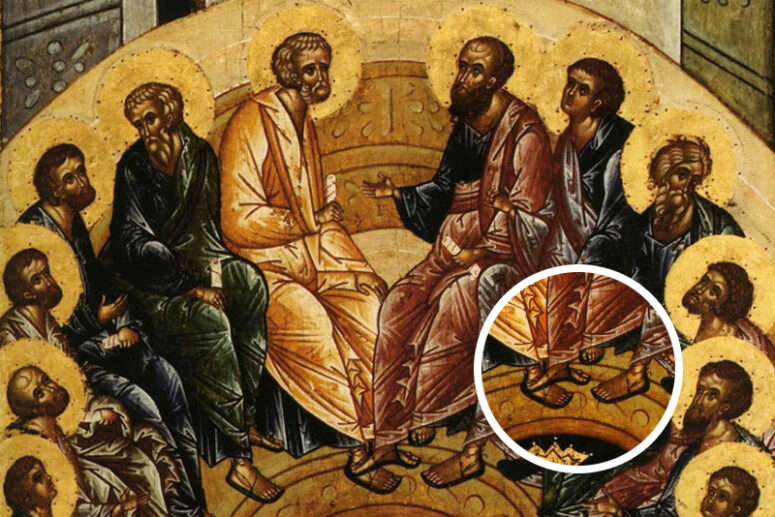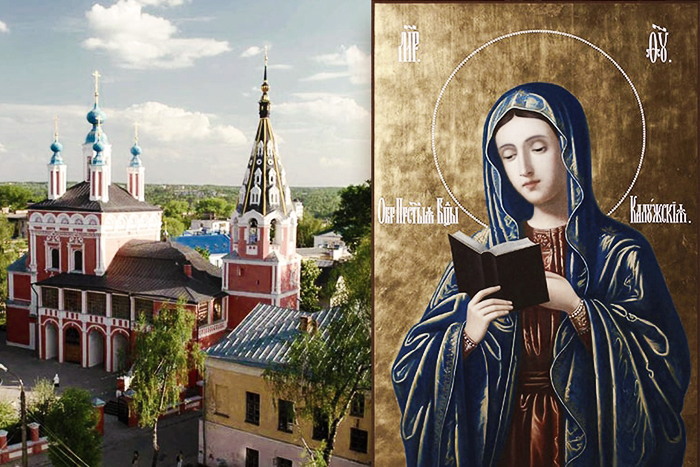
Even the most inconspicuous or habitual objects on Orthodox icons have a spiritual meaning. Even the smallest details, like folds of clothes, can bear witness to the spiritual mood of a depicted saint. In this article, we offer a glimpse of a few subtle and unusual details that will help you to better understand Orthodox iconography.
St Paul Stepping on St Peter’s Foot
You can find this gesture on icons of the Descent of the Holy Spirit on the Apostles. It is extremely subtle and almost unknown. Despite its deep symbolic meaning, this detail is omitted on some icons.


Despite the fact that St Paul could not have been present among the apostles on the day of Pentecost, (because he had not yet converted to Christ) he is still depicted on the icon, since Pentecost is the day of the creation and establishment of the Church. The gesture of St Paul, stepping on the foot of St Peter, signifies the recognition of St Paul’s missionary merits. The labours of this apostle “of the second call” for the good of founding Churches were especially fruitful among the rest of the disciples.
Velum
In iconography, velum (from Latin – sail) is a red fabric draped between two architectural structures or elements. A velum can be seen, for example, on icons depicting the Nativity or the Annunciation of the Theotokos, as well as the Meeting of the Lord.

The presence of a velum on a particular icon may have several meanings. First, it may indicate that the events depicted on the icon take place indoors. On certain icons, the action takes place inside the building over which the velum hangs. Velum may also be used to signify events that take place secretly, away from prying eyes.
However, the main meaning of the velum is the connection and succession between the Old and New Testaments. The very form of the velum signifies the red woven veil, used in the Temple of Jerusalem, as well as in all Orthodox churches.
Mandorla
The mandorla is a round or oval aureole, inside of which the figure of Christ is placed. Sometimes a mandorla surrounds the figure of the Blessed Virgin, angels or saints. Most often, a mandorla can be seen on icons of the Transfiguration, Resurrection or the Second Coming of Christ.


The mandorla is used by an icon-painter to represent a holy person in divine glory. The arrow-shaped rays signify the energy of God, the heavenly forces inside the mandorla show the power of God, while the radiance of the mandorla symbolises the glory of God.
Profile and En-face Facial Images
Spontaneous elements are rare in the symbolic language of iconography. Even the smallest details matter, including the angle at which the faces are depicted. Look at the icon below, for example.

It is customary to depict the Lord, the Mother of God, angels and saints in full face or turned three quarters to the beholder. Common people are depicted turned either in profile or away from the praying person.
Symbolically, this is explained through the concept of an icon as a means of prayer communication. The persons facing one another (including the beholder) enter this communication, while those depicted in profile are excluded from it.
Folds of Clothes
The folds of clothing can say much about both the icon itself and the portrayed image. Many small folds indicate that the icon was painted between the eighth and the fourteenth century. A small number of long folds indicates that the icon was likely painted after the fourteenth century.
Short folds symbolize spiritual excitement, while long folds point to spiritual peace. Uneven folds symbolize movement.

Caves
Images of a cave are found on icons of the Nativity of Christ, as well as certain ascetic anchorites. Indeed, Christ was born in the Bethlehem cave, while ascetics like St Macarius the Great spent years in the caves of the Natrn Valley.
Symbolically, however, a cave means the underworld. The darkness of a cave is the darkness of hell. Caves are depicted as a reminder that Christ descended into hell and destroyed its gates, and that the Light of Christ conquers any darkness.


Grotesque Architecture
Buildings on icons look illogical and strange. The geometric forms of facades can be emphatically impossible. Doors may reach the ceiling of the building, while windows are installed in places where they cannot be used. Even the size of windows and doors can make their presence meaningless.
The significance of such buildings, deliberately nonsensical from an architectural point of view, is to show that the events depicted on the icon are outside the laws of earthly logic. Despite the fact that these events happen on earth, their primary dimension is the spiritual world.
It is impossible to fully understand the essence of what is depicted on an icon without knowing its symbolic language. Since most iconographic details, from the background color to the folds of clothes, have a spiritual meaning, learning to read icons is necessary in the same way as learning to read in general. Mastering this language allows rediscovering a familiar icon, in the same way as we take a fresh look at a well-known book .







I can’t recall where or when, but I was once told that faces portrayed in full profile (such as the image of satan attempting to get Joseph to doubt in icons of The Nativity) are portrayed that way so as to indicate that the individual is not fully human. Have you ever heard this?
Thank you.
Rdr. Gregory Manning
Frankly speaking, I have never heard of it. I guess it may be true in some cases though.
You’re always welcome!
In Christ,
I just found some images that clearly illustrate that
1
2
3
If both St.Anthony and St.Macarius lived in caves and deserts, why is it that the latter is portrayed with a hairy border without clothes but not the former saint. I think it is very fitting for the latter to be portrayed that way but not the other way haha. St.Macarius is one of my fav saints!
@marcus St. Macarius in question actually had only hair and beard as his clothes. To avoid confusion this is not St. Macarius the Great, but St. Macarius the Roman of Mesopotamia.
We read this from his life:
“Then they saw an old man walking toward them, covered only by his hair and a beard which reached his knees.”
https://www.oca.org/saints/lives/2021/10/23/206395-saint-macarius-the-roman-of-mesopotamia